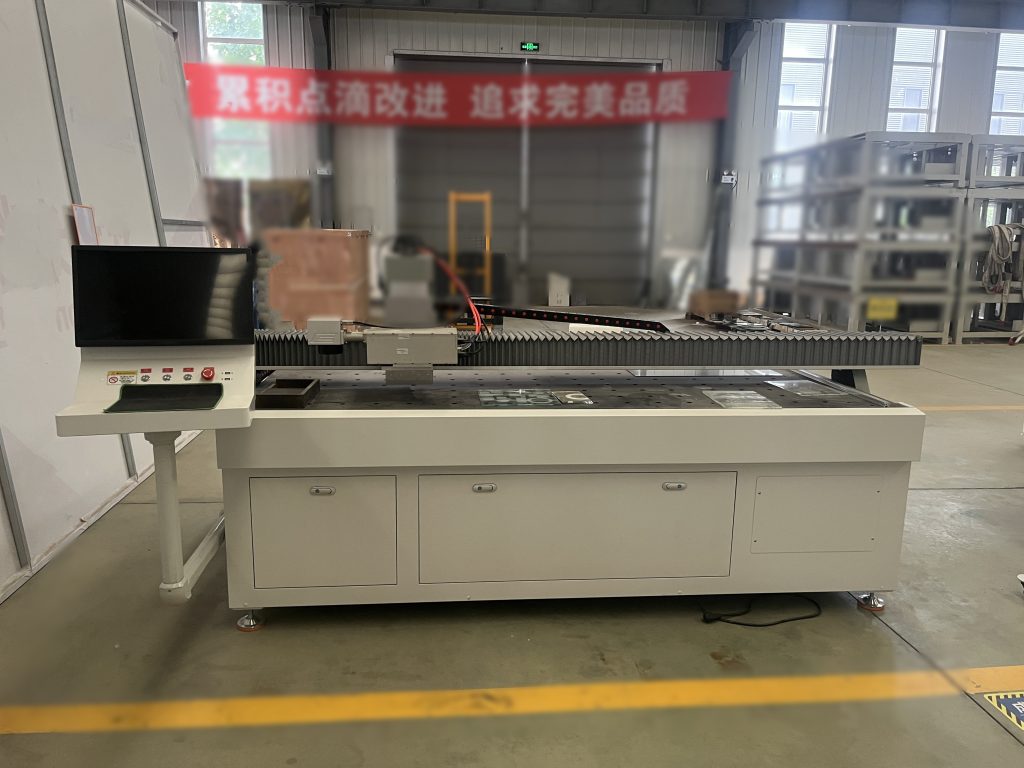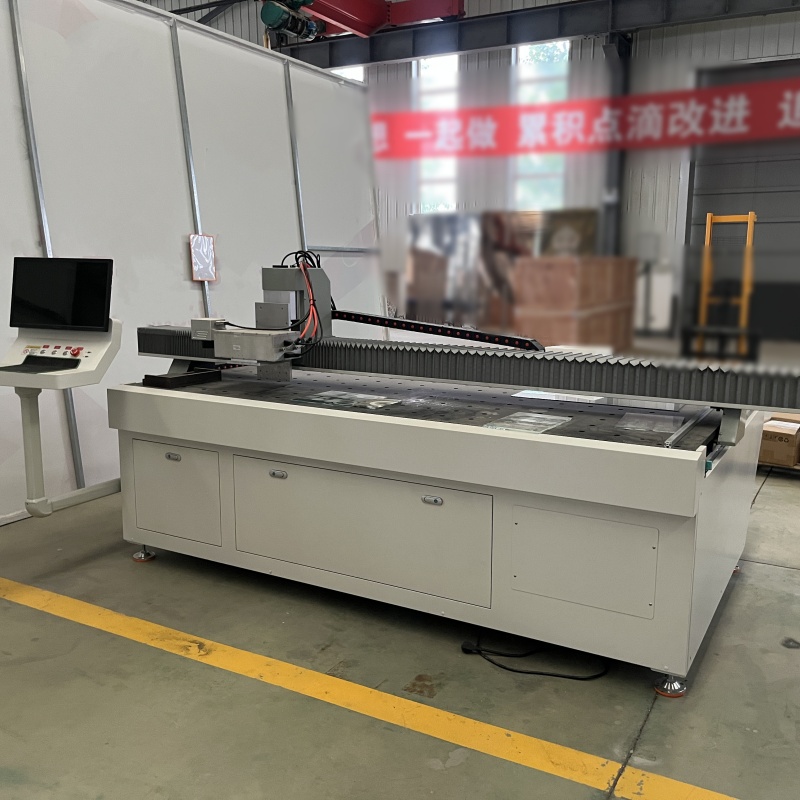I.Laser frosting engraving machine (three-in-one principle)
Laser equipment uses the thermal effect or photochemical effect of high-energy laser beams to achieve precise processing of sandblasting, drilling, and paint removal. Its core principles are as follows:
1.Sandblasting principle (laser etching/roughening)
Principle: Use the high energy density of the laser beam to irradiate specific areas on the glass surface, so that the surface material instantly vaporizes or melts, forming micron-level pits or rough textures.
Key technologies:
Beam control: Through the galvo scanner system or dynamic focusing system, quickly scan the laser beam to “carve” a uniform or specific pattern of rough surface (such as frosted effect) on the glass surface.
Energy regulation: Control the laser power and pulse frequency, adjust the etching depth (shallow to only damage the coating layer, deep to erode the glass matrix), and achieve sandblasting effects of different roughness (such as matte surface, fog surface).
Application scenarios: Decorative sandblasting of smart mirror surfaces (such as frame texture, logo engraving), anti-glare treatment (rough surface scattering light).
2.Punching principle (laser cutting/ablation)
Principle: The energy density of the focused laser beam is extremely high (up to 10000 nm), which irradiates the position of the glass to be punched, causing the material to vaporize and evaporate rapidly. At the same time, auxiliary gases (such as oxygen and nitrogen) are used to blow away the molten residue to form a through hole.
Key technologies:
Focus control: Through the high-precision Z-axis focusing system, the laser focus is accurately positioned at a certain position in the thickness direction of the glass to achieve layer-by-layer ablation from the surface to the bottom layer.
Path planning: The software controls the laser beam to scan along a preset trajectory (such as a circle or a special shape), gradually “cutting” out holes, and the edges of the holes are automatically smooth (without burrs) due to high-temperature melting.
Advantages: It can process micron-level small holes or complex-shaped holes (such as ellipses and polygons), with fast speed (such as 12mm thick glass punching a 100mm hole in only 144 seconds), and no mechanical stress damage.
3.Principle of paint removal (laser stripping/cleaning)
Principle: Use the interaction between laser and paint film (thermal expansion effect or photolysis effect) to make the paint film fall off from the glass surface.
Thermal expansion stripping: After the laser energy is absorbed by the paint film, it instantly heats up and expands, causing a stress difference with the glass matrix, causing the paint film to crack and peel off.
Photolysis: Lasers of specific wavelengths (such as ultraviolet lasers) react photochemically with the paint film, destroying molecular bonds and decomposing the paint film into volatile small molecules.
Key technologies:
Wavelength matching: Select the laser wavelength according to the paint film material (such as organic coatings, metal coatings) (such as CO₂ lasers are suitable for organic coatings, and fiber lasers are suitable for metal films).
Energy threshold control: Precisely adjust the laser energy to only destroy the paint film without damaging the glass matrix (non-thermal damage mode).
Application scenarios: Remove old paint films, positioning marks or excess coating layers on the surface of smart mirrors to achieve local transparency (such as paint removal in the camera opening area).

II. Abrasive frosting engraving machine (three-in-one principle)
Abrasive equipment uses high-pressure airflow or liquid to carry abrasives (such as corundum, glass beads) and spray them onto the glass surface to achieve sandblasting, drilling, and paint removal. The principles are as follows:
1. Sandblasting principle (abrasive impact roughening)
Principle: A high-pressure air source (such as an air compressor) accelerates the abrasive (particle size 20-200 mesh) to high speed and sprays it onto the glass surface. Through the impact and micro-cutting of the abrasive, countless tiny pits are produced on the surface to form a frosted effect.
Key parameters:
Abrasive type: corundum (aluminum oxide) is used for coarse sandblasting, and glass beads are used for soft sandblasting (finer texture).
Pressure and distance: The higher the air pressure and the closer the nozzle distance, the deeper the sandblasting depth (larger adjustable range).
Application scenarios: large-area uniform sandblasting (such as anti-fog frosting of bathroom mirrors), low-cost decorative treatment.
2. Punching principle (abrasive erosion to form holes)
Principle: The high-speed abrasive flow is concentrated at one point through the focusing nozzle, continuously impacting the glass surface, and gradually “drilling” holes. In the process, the kinetic energy of the abrasive is converted into impact and crushing energy on the glass, removing the material to form a through hole.
Limitations:
The aperture is limited by the nozzle size (usually greater than 1mm), and the edge of the hole may be broken and requires subsequent polishing.
The efficiency is lower than laser drilling, especially for thick glass. It takes a long time to process.
3. Paint removal principle (abrasive stripping paint film)
Principle: The high-speed abrasive flow impacts the surface of the paint film, and uses mechanical force to strip the adhesion between the paint film and the glass, causing the paint film to break and fall off.
Key control:
Abrasive hardness: Select abrasives with a harderness higher than the paint film (such as quartz sand) to avoid excessive damage to the glass substrate.
Pressure adjustment: Low pressure is used for mild paint removal (such as thin coatings), and high pressure is used for stubborn paint film removal.
Features: Suitable for large-area paint removal, but with low precision, it may cause slight scratches on the glass surface.



